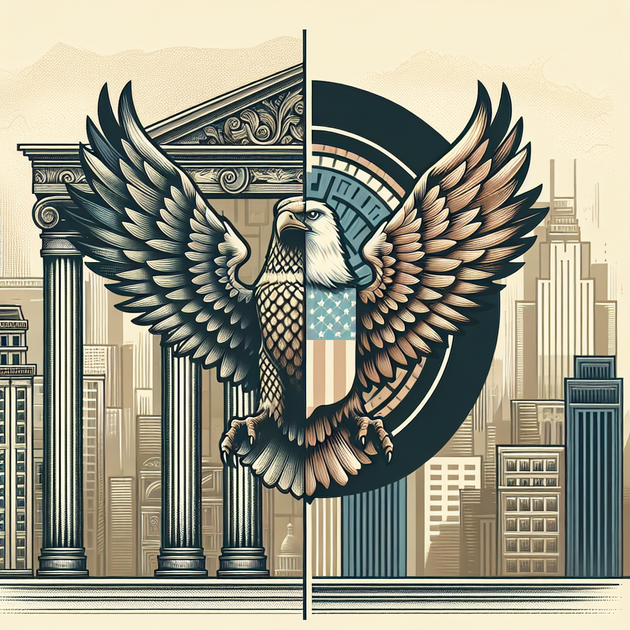Have you ever looked at an old Roman coin and thought, “Hey, that eagle looks familiar?” There’s a reason for that—and it goes way beyond national birds and shiny emblems. The comparison between the United States and ancient Rome pops up every now and then, especially whenever things feel a little shaky in the world. But is America really following in Rome’s footsteps toward collapse—or are we just seeing patterns where there aren’t any?
Let’s break down what actually lines up, what doesn’t, and why this comparison keeps coming back.
## Why Do People Keep Comparing the US and Rome?
First off, it’s not just about eagles. Sure, both the US and Rome use the bird as a symbol of power and freedom. But when people make this comparison, they’re usually thinking bigger—like how both countries started out as republics with democratic ideas, became huge global forces, and eventually dealt with all sorts of political drama.
What’s interesting is how certain details overlap:
– Both had a Senate (though they worked very differently).
– Both spread their culture far beyond their borders.
– Both faced challenges trying to hold together a massive, diverse population.
But history isn’t just a copy-paste situation. The world is very different now than it was 2,000 years ago—but some things do feel oddly familiar.
## The East-West Parallel: Are Blue States the New Byzantium?
This one’s new to me. In the Reddit post that sparked this article, someone pointed out that when Rome “fell,” it wasn’t all at once. The Western Roman Empire crumbled first—the side that was poorer, less urbanized, more rural. Meanwhile, the Eastern Roman Empire (which became known as Byzantium) hung on for almost another thousand years because it had more people, more money, and bigger cities.
Now here’s where things get weirdly close to home: In today’s US, there’s often talk about “blue states” like California or New York being richer, more urbanized, and having larger populations compared to many “red states,” which tend to be more rural with smaller economies. Some folks have even joked that if America ever split apart (not saying it will!), you might see something similar—with wealthier states sticking around while others face harder times.
Of course, history isn’t destiny. But you can see why people draw these lines.
## Is Our Downfall Inevitable—Or Are We Just Stressed?
It’s easy to get caught up in doomscrolling these days. Every news alert can feel like another piece falling off a crumbling empire. But let’s be real for a second: Rome fell for a lot of reasons—bad leaders, invasions from outside groups, economic problems, plagues… the list goes on.
Here are some things people point out as parallels between ancient Rome and modern America:
– Political gridlock making big decisions hard
– Huge differences between rich and poor
– Military stretched too thin overseas
– Arguments over who should really be in charge
– A general sense of “are things getting worse?”
But there are also some key differences:
– We’ve got technology Rome couldn’t dream of
– Our government structure is pretty different
– We live in a globalized world where everything is connected
So while it might *feel* like history repeating itself sometimes, there are still lots of ways things could go differently.
### Quick List: Similarities People Notice Between Rome & the US
– Both started as republics before getting super powerful
– Big focus on military strength
– Love of public entertainment (think Roman games vs. our sports)
– Wide gap between rich and poor at certain points
– Arguments over immigration and who counts as a “real” citizen
## A Story From My Own Couch
Let me tell you—I once got sucked into an hours-long YouTube rabbit hole after watching a documentary about ancient Rome. I sat there thinking about how senators once argued in marble halls while worrying about barbarians at the gates…and then my phone buzzed with news about another heated debate in Congress.
It made me laugh—a little nervously—because no matter how much we think we’re different from people thousands of years ago, some worries just don’t change much. My cat didn’t care either way; she just wanted dinner.
## So…Are We Doomed or What?
If you came here hoping for a simple answer—sorry! History almost never works out exactly the same way twice. Yes, there are some wild similarities between America right now and Rome back then. But there are also plenty of differences that make any direct prediction tricky at best.
Honestly? Maybe thinking about these parallels is less about predicting disaster—and more about reminding ourselves to pay attention to what matters: keeping society fairer for everyone, fixing problems before they get too big (hello climate change), and learning from mistakes instead of repeating them.
What do you think? Does comparing America to ancient Rome help us understand our own time—or does it just distract us from real solutions? I’d love to hear your take.

Leave a Reply